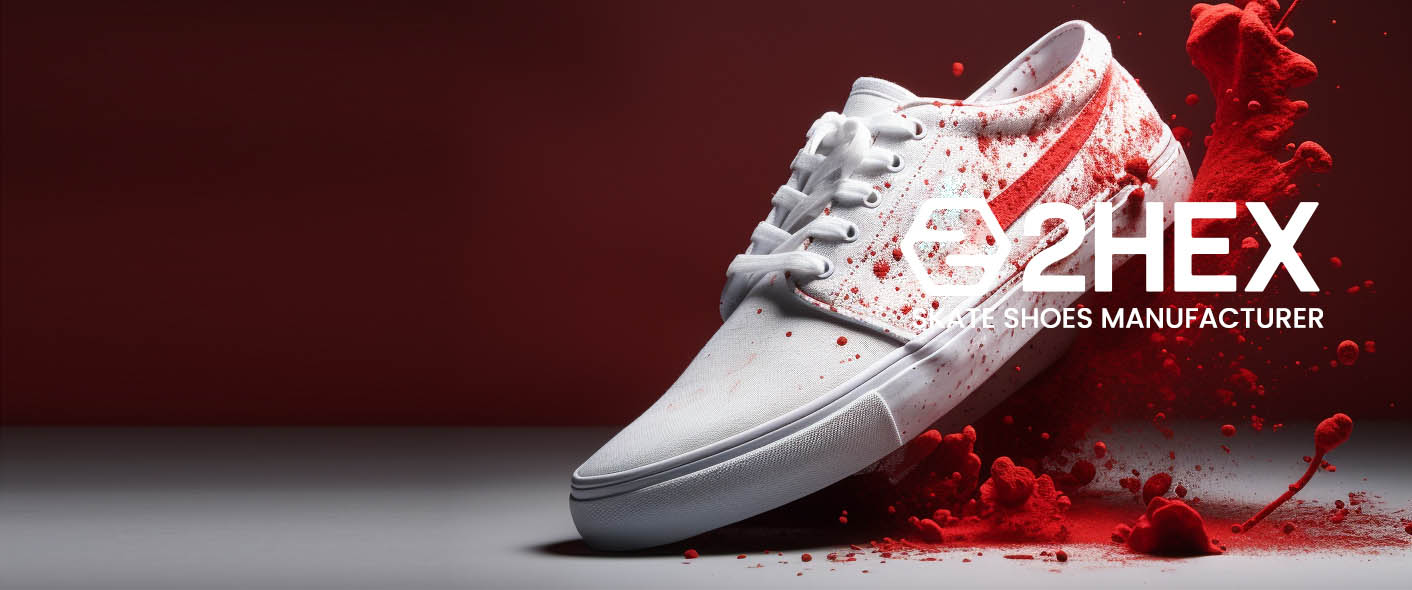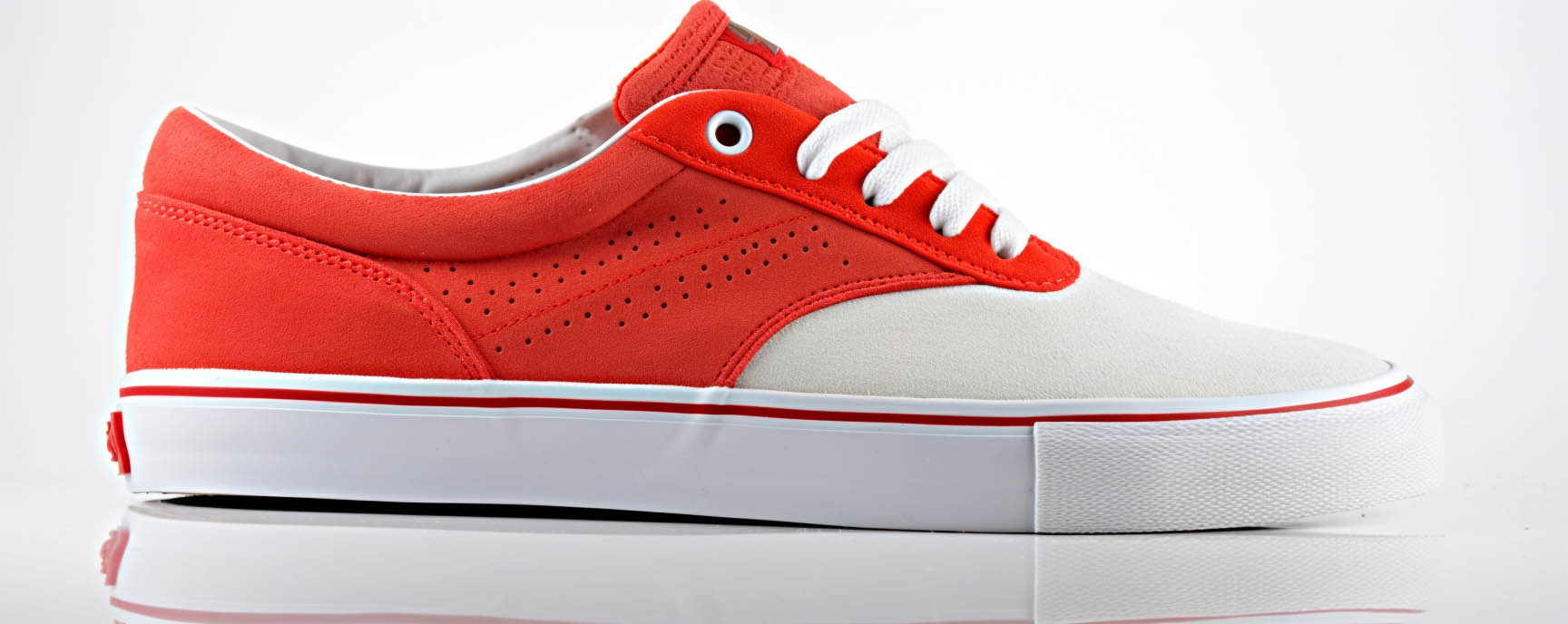
2HEX Skate Shoes Factory
Welcome to 2HEX Skate Shoes Factory, where we combine style, performance, and durability to create the ultimate skate shoes for street, park and vert skateboarding. As passionate skaters ourselves, we understand that the perfect skate shoe is much more than just a fashion statement. It's a vital piece of equipment that enhances your skating skills while providing the necessary protection and support for your feet.
Our skate shoe factory production process is focused on incorporating advanced technology and innovative materials to deliver shoes that truly cater to the unique needs of skateboarders.
We begin by meticulously selecting the finest raw materials for our skate shoes. This includes using durable, wear-resistant fabrics and leather that can withstand the rigors of skateboarding, along with cushioning and support materials that offer the perfect balance of comfort and responsiveness.
The design process is driven by a deep understanding of skateboarding mechanics and the precise movements involved. We work closely with professional skateboarders and skate enthusiasts to gather valuable feedback, ensuring that our shoes provide the right amount of grip, flexibility, and support needed for optimal board control.
We employ reinforced stitching techniques and high-quality adhesives to enhance durability, while also ensuring that each shoe maintains a lightweight feel for effortless movement.
Finally, we are committed to environmental responsibility and sustainability. We strive to minimize our carbon footprint by utilizing eco-friendly materials and practices throughout the production process, ensuring that our skate shoes not only perform at their best but also contribute positively to our planet.
Our passion for skateboarding and commitment to excellence drive us to create shoes that not only look great but also elevate your skateboarding performance. Welcome to the future of skate shoe innovation!
Contact Us
Skate Shoe Manufacturing Materials
Skate shoes are typically crafted using a variety of materials, each with their unique benefits and drawbacks. Here, we will discuss common materials used in the production of skate shoes, grouped by upper, insole, and outsole components.
Skate Shoes Upper:
1) Canvas:
- a) Pros: Lightweight, breathable, and affordable. Canvas provides good flexibility and comfort while skating.
- b) Cons: Less durable compared to other materials, may wear out quickly with intense skateboarding, and offers limited support.
2) Suede:
- a) Pros: Offers excellent durability, grip, and abrasion resistance, making it a popular choice for skate shoes. Suede provides a good balance of flexibility and support.
- b) Cons: Heavier and less breathable than canvas, may take longer to break in, and can be more expensive.
3) Leather:
- a) Pros: Durable, supportive, and water-resistant. Leather skate shoes are long-lasting and provide good protection for the feet.
- b) Cons: Less breathable than other materials, heavier, and can be more expensive. Leather shoes may also take longer to break in.
4) Synthetic Materials:
- a) Pros: Lightweight, breathable, and often more affordable than natural materials. Synthetic materials can be designed to mimic the properties of leather or suede.
- b) Cons: May not offer the same level of durability and support as natural materials, and some synthetic materials may not be environmentally friendly.
Skate Shoes Insole:
1) EVA (Ethylene-vinyl acetate):
- a) Pros: Lightweight, flexible, and offers good cushioning. EVA is a popular material for skate shoe insoles due to its shock absorption capabilities.
- b) Cons: Can compress over time, which may result in reduced cushioning and support.
2) PU (Polyurethane):
- a) Pros: Offers excellent support, durability, and shock absorption. PU insoles are known for their long-lasting performance.
- b) Cons: Heavier and less breathable than EVA insoles, and can be more expensive.
3) Memory Foam:
- a) Pros: Molds to the shape of the foot, providing a customized fit and enhanced comfort.
- b) Cons: Can retain heat, which may be uncomfortable for some skaters, and may not offer the same level of support as other insole materials.
Skate Shoes Outsole:
1) Vulcanized Rubber:
- a) Pros: Provides excellent flexibility, grip, and board feel. Vulcanized rubber outsoles are popular among skateboarders due to their lightweight and responsive properties.
- b) Cons: May wear out faster than other outsole materials and may offer less impact protection.
2) Cupsole:
- a) Pros: Offers increased support, durability, and impact protection compared to vulcanized rubber. Cupsoles are ideal for skaters who perform high-impact tricks.
- b) Cons: Heavier and less flexible than vulcanized rubber, which can result in a reduced board feel.
By understanding the pros and cons of these materials, skate shoe manufacturers can create products that cater to the diverse needs of skateboarders, ensuring optimal performance and durability.
Contact Us

Prepare and submit your skate shoes design
Preparing a comprehensive design file for skate shoe production is a crucial step in ensuring your vision translates into a high-quality finished product. Here is a step-by-step guide to creating a design file that you can send to 2HEX’ skate shoe factory team:
- Concept Sketches Start by creating a series of rough concept sketches to visualize your skate shoe
design. Focus on the overall shape, silhouette, and key features. You can use traditional drawing tools or
digital illustration software, such as Adobe Illustrator or Photoshop.
- Detailed Design Refine your concept sketches into a detailed design. Create a clean, precise drawing that
clearly shows the shoe's profile, including the upper, midsole, and outsole. Make sure to include all
essential components, such as laces, eyelets, padding, and reinforcements.
- Colorways and Materials Choose the materials and color schemes for your skate shoe. Indicate the
desired materials (e.g., suede, leather, canvas) and their color codes (Pantone or CMYK) for each part of
the shoe. Create color swatches or overlay the colors onto your detailed design to provide a clear visual
representation.
- Technical Specifications Create a technical specification sheet that includes all dimensions,
measurements, and construction details. Specify the measurements for the various parts of the shoe, such
as the length, width, and height. Include information on stitching, reinforcements, and any other relevant
construction techniques.
- Orthographic Views: Create orthographic views of your skate shoe design, showing the front, back, side,
top, and bottom perspectives. These views will help the factory accurately interpret your design and
provide a clear understanding of its three-dimensional structure.
- Component Breakdown Provide a detailed breakdown of each component in your design, including the
upper, tongue, collar, insole, and outsole. Specify the materials, thicknesses, and any other relevant
information for each part. Include detailed illustrations or diagrams if necessary.
- Annotations and Callouts Add clear annotations and callouts to your design file, explaining specific
details or instructions that may be essential for the factory to understand. Be concise and precise in your
language to avoid confusion.
- File Format Save your design file in a universally accepted format, such as PDF, AI, or EPS. This will
ensure that the factory can easily open and view the file without compatibility issues.
- Documentation Compile all the information, sketches, orthographic views, technical specifications, and
component breakdowns into a single, well-organized document. Make sure it's easy to navigate and
understand, with a table of contents and clear headings.
- Review and Approval Before sending your design file to the factory, review it thoroughly to ensure
accuracy and completeness. Consult with a footwear designer or a 2HEX production expert to verify that
your design is feasible and ready for production.
Once your design file is complete and approved, you can confidently send it to us, knowing that you've provided all the necessary information to bring your skate shoe vision to life.
Contact us here, and we will connect you to your skate shoe production expert.
The Real Deal Behind Skate Shoe Production Costs
Let's drop in and talk about what's kickflipping the costs of skate shoe production up or down. As a premier skate shoes manufacturer, we're tuned into the skate scene like a well-waxed ledge and we're breaking it down for you, as clear as a freshly swept skatepark.
- Skate Shoe Materials: The raw materials we use are the solid foundation of the production cost. Suede, canvas, synthetic materials, EVA, PU, and various types of rubber all have a role to play. The quality and type of these materials can drastically shift the final cost of the skate shoes.
- Skate Shoe Manufacturing Process: Intricate skate shoe designs can take more time and craftsmanship to manufacture. The more detailed the design, the more steps involved, and that can increase production costs.
- Skate Shoe Quantity: The amount of pairs you're ordering also slides into the equation. More pairs means lower per-unit costs because, let's be real, we're all about that volume.
- Skate Shoe Styles: More styles result in more unique molds, different materials, and potentially different assembly lines. The more variety, the more intricate the production process, and that can nudge the cost up.
- Skate Shoe Sizes: Dishing out a wide range of sizes can complicate the production process. Different sizes call for different molds and assembly tweaks.
- Skate Shoe Packaging: Whether you want bare-bones or top-notch packaging, it all feeds into the total cost. Want custom branding elements? That's an additional charge.
The cost for each pair of skate shoes can bounce between $14 to $30. The price is swayed by order volume and shoe specs. If you're stepping up to make a shoe order with us, you should be prepped with at least $20,000. We concentrate on large-scale production and orders that give the best bang for the buck for our customers.
For those of you looking to start with the core essentials for professional-grade skate shoes, you're eyeing a minimum order of 1,000 pairs. Equipped with the basics for hardcore skating - a durable suede upper, a rubber outsole, and a design that fits like a glove - the cost per pair would hover around $18. As you scale up to 10,000 pairs, the cost per pair could dip to around $14. And that, skaters, is the stoke of economies of scale in the skate shoe production scene.
2HEX Shoes Contact
